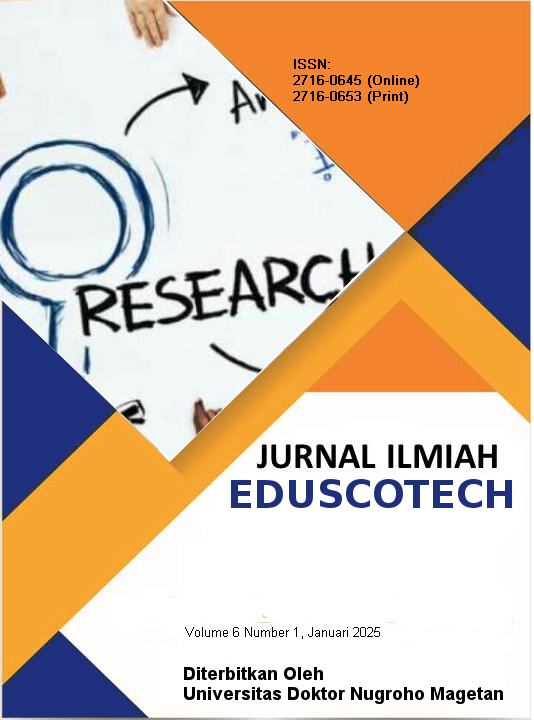Pemanfaatan Kulit Buah Naga sebagai Pewarna Alami pada Produk Selai Stroberi
Keywords:
Dragon Fruit Peel, Anthocyanin, Natural Colorant, Strawberry Jam, Sensory EvaluationAbstract
This study explored the application of red dragon fruit (Hylocereus sp.) peel extract as a natural colorant in strawberry jam, focusing on its impact on color quality, anthocyanin content, physicochemical properties, and consumer acceptance. Extracts containing high anthocyanin levels were incorporated at 0% (control), 5%, 10%, and 15% concentrations. Color measurements using a Chromameter showed that increasing extract concentration enhanced the a* value (red intensity) while reducing the L* value (lightness). The 10% formulation produced a bright red color comparable to fresh strawberries, whereas 15% yielded a reddish-purple tone. Anthocyanin levels, determined by the pH differential method, significantly increased with extract addition, reaching 38.5 mg/100 g at 15% compared to 5.2 mg/100 g in the control. Physicochemical analysis indicated moisture contents between 28–30% and pH values of 3.4–3.6, meeting the Indonesian National Standard (SNI 3746:2008) for fruit jams. Sensory evaluation with 30 semi-trained panelists revealed that the 10% treatment achieved the highest scores for color (8.2), taste (8.0), and overall acceptability (8.3), without detectable off-flavors. At 15%, slight bitterness and a characteristic dragon fruit peel aroma were noted, likely due to elevated phenolic content. The results suggest that 10% dragon fruit peel extract provides the best balance between visual appeal, nutritional benefits, stability, and consumer preference. This finding supports the development of clean-label products and promotes sustainability by utilizing agricultural by-products, contributing to a zero-waste and circular economy approach.
Downloads
References
Ghorpade, V. M., Hanna, M. A., & Kadam, S. S. (2020). Coloring agents in food. Critical Reviews in Food Science and Nutrition, 60(18), 3103–3116. https://doi.org/10.1080/10408398.2019.1709493
Winarno, F. G. (2019). Kimia Pangan dan Gizi. Jakarta: Gramedia Pustaka Utama.
Zhou, C., Li, X., Ma, H., & Yang, W. (2020). Extraction, structural characterization, and bioactivities of anthocyanins from purple sweet potato: A review. Critical Reviews in Food Science and Nutrition, 60(14), 2393–2405. https://doi.org/10.1080/10408398.2019.1631750
Khoo, H. E., Azlan, A., Tang, S. T., & Lim, S. M. (2017). Anthocyanidins and anthocyanins: Colored pigments as food, pharmaceutical ingredients, and potential health benefits. Food & Nutrition Research, 61(1), 1361779. https://doi.org/10.1080/16546628.2017.1361779
Herbach, K. M., Stintzing, F. C., & Carle, R. (2006). Impact of thermal treatment on color and pigment pattern of red beet (Beta vulgaris L.) preparations. Journal of Food Science, 71(6), C441–C448. https://doi.org/10.1111/j.1750-3841.2006.00030.x
Khoo, H. E., Azlan, A., Tang, S. T., & Lim, S. M. (2017). Anthocyanidins and anthocyanins: Colored pigments as food, pharmaceutical ingredients, and potential health benefits. Food & Nutrition Research, 61(1), 1361779.
Nurliyana, R., Syed Zahir, I., Mustapha Suleiman, K., Aisyah, M. R., & Kamarul Rahim, K. (2010). Antioxidant study of pulps and peels of dragon fruits: A comparative study. International Food Research Journal, 17, 367–375.
Zhou, C., Li, X., Ma, H., & Yang, W. (2020). Extraction, structural characterization, and bioactivities of anthocyanins from purple sweet potato: A review. Critical Reviews in Food Science and Nutrition, 60(14), 2393–2405. https://doi.org/10.1080/10408398.2019.1631750
Downloads
Published
Issue
Section
License

This work is licensed under a Creative Commons Attribution-ShareAlike 4.0 International License.
Authors who publish with this journal agree to the following terms:
1. Copyright on any article is retained by the author(s).
2. The author grants the journal, right of first publication with the work simultaneously licensed under a Creative Commons Attribution License that allows others to share the work with an acknowledgment of the work’s authorship and initial publication in this journal.
3. Authors are able to enter into separate, additional contractual arrangements for the non-exclusive distribution of the journal’s published version of the work (e.g., post it to an institutional repository or publish it in a book), with an acknowledgment of its initial publication in this journal.
4. Authors are permitted and encouraged to post their work online (e.g., in institutional repositories or on their website) prior to and during the submission process, as it can lead to productive exchanges, as well as earlier and greater citation of published work.
5. The article and any associated published material is distributed under the Creative Commons Attribution-ShareAlike 4.0 International License









